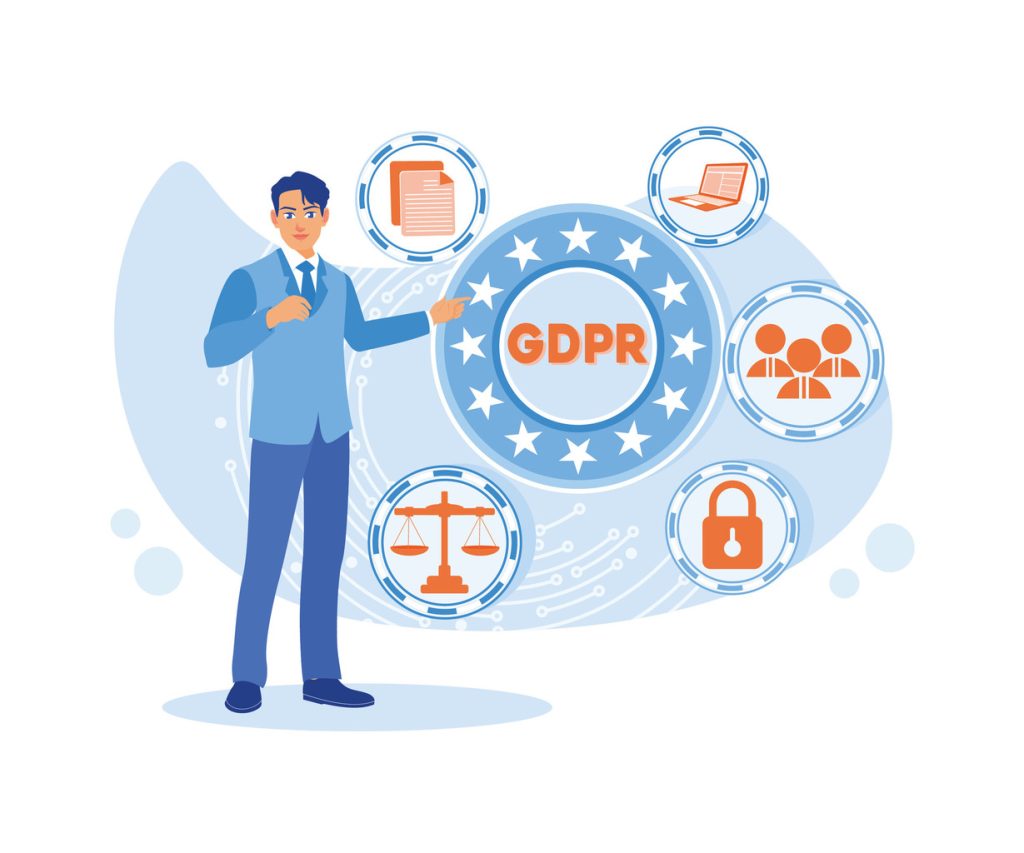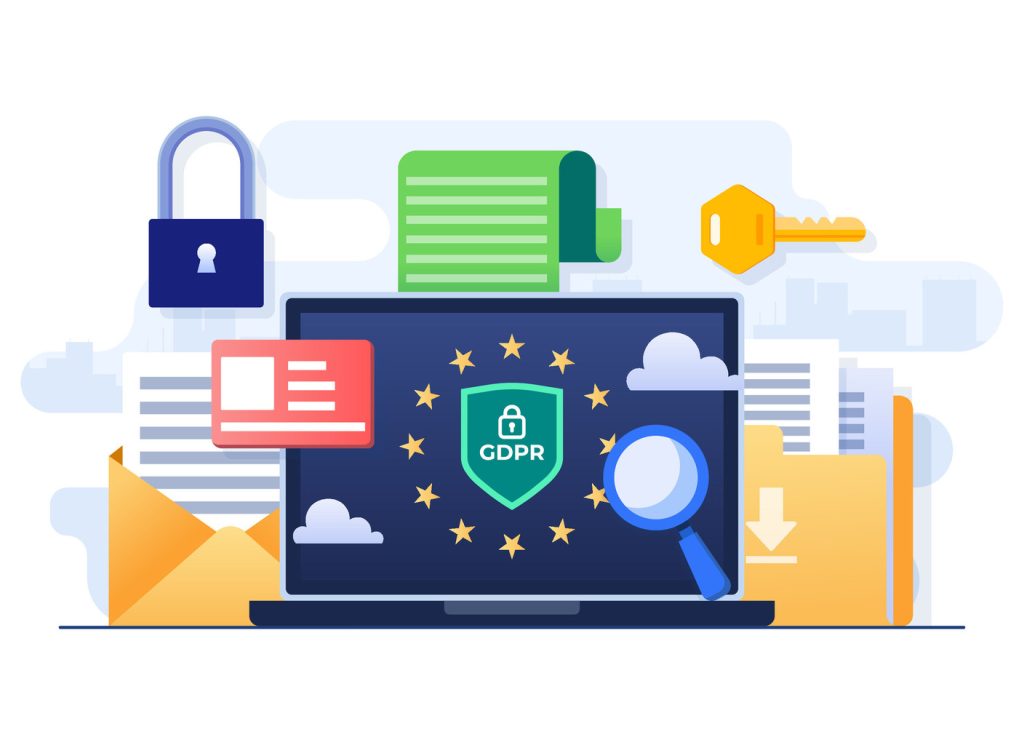Mastering GDPR Compliance: Essential Steps Explained

Businesses operating in today’s digital landscape face unprecedented challenges in safeguarding sensitive information. A landmark data protection framework, enacted in May 2018, reshaped global standards for handling personal details. This regulation applies to any organization processing EU residents’ data, regardless of its physical location.
Non-adherence carries significant risks. Penalties can exceed €20 million or 4% of annual revenue—whichever is higher. Beyond financial consequences, mishandling data erodes customer trust and damages brand reputation. Leaders must adopt systematic approaches to align operations with rigorous privacy requirements.
Successful implementation requires more than checkbox exercises. Organizations need actionable strategies that transform complex legal text into practical workflows. This includes documenting processes, training teams, and establishing clear accountability structures. Viewing these efforts as investments rather than burdens creates opportunities to differentiate through ethical data stewardship.
Key Takeaways
- Global data laws impact companies beyond EU borders if they handle European residents’ information
- Financial risks include fines up to 4% of annual revenue for violations
- Operational changes must address documentation, security protocols, and staff training
- Proactive compliance builds customer confidence and market credibility
- Effective implementation requires translating legal requirements into daily business practices
Understanding the GDPR Landscape
Modern privacy standards trace their roots to postwar Europe. The 1950 European Convention on Human Rights first recognized privacy as fundamental. Decades later, rapid tech advances exposed gaps in older frameworks like the 1995 Data Protection Directive. This set the stage for a groundbreaking update.
What the Regulation Is and Why It Matters
The General Data Protection Regulation (GDPR) reshaped how organizations handle personal information. It establishes strict rules for processing data while giving individuals control over their digital footprints. More than legal checkboxes, these standards reflect evolving expectations about privacy in connected societies.
Three core objectives drive the framework: protecting individual rights, harmonizing laws across borders, and addressing modern tech challenges. Businesses that embrace these principles often see improved customer relationships and operational transparency.
Historical Development and Global Impact
Europe’s journey from fragmented national laws to unified data protection rules took 23 years. The GDPR replaced 28 different systems with one enforceable standard—creating predictability for multinational operations.
Over 130 countries have since modeled laws on this framework. Its influence extends beyond Europe, pushing U.S. companies to adopt stronger safeguards. Organizations recognizing this legacy position themselves as leaders in ethical information management.
Why GDPR Compliance Matters for U.S. Businesses

The misconception that physical headquarters determine legal obligations creates hidden risks for U.S. enterprises. Any organization handling European residents’ information—whether through sales, services, or digital tracking—operates within strict privacy frameworks.
Understanding Cross-Border Requirements
American companies processing details about EU individuals must meet specific criteria. This applies even if transactions occur on U.S. soil. Free trials, newsletter sign-ups, or behavioral analytics all qualify as engagement triggers.
Monitoring website users through cookies or IP tracking establishes jurisdiction. Firms collecting browsing patterns or location details often need updated consent mechanisms. Proactive adaptation prevents costly penalties and operational disruptions.
| Business Activity | Regulatory Relevance | Action Steps |
|---|---|---|
| E-commerce sales to EU customers | High | Implement geo-targeted privacy notices |
| Social media ad campaigns | Moderate | Audit tracking technologies |
| Mobile app usage analytics | High | Develop data deletion protocols |
| Email marketing to European addresses | High | Establish lawful processing bases |
Strategic alignment with these standards unlocks market opportunities. Over 60% of European consumers prefer brands with transparent data practices. Building trust through ethical handling strengthens competitive positioning.
Documentation proves critical during audits. Organizations must record how they collect, store, and share personal data. Regular reviews ensure processes match current legal interpretations.
Core GDPR Principles and Data Protection Fundamentals
Effective data protection strategies begin with understanding seven foundational rules. These standards transform abstract concepts into operational guardrails for organizations handling sensitive details. They balance individual rights with business needs through measurable actions.
Building Trust Through Clear Practices
Every interaction with personal data requires lawful justification. Companies must identify specific reasons for collecting information – like contract fulfillment or user consent. Transparent communication about processing methods builds consumer confidence.
Fairness demands alignment with reasonable expectations. Unexpected uses of data violate core principles. Regular audits help ensure activities match disclosed purposes.
Strategic Limitations and Proof of Action
The minimization principle prevents unnecessary collection. Businesses should implement filters that capture only essential details. Storage timelines require equal attention – outdated records become liabilities.
Accountability goes beyond policy documents. Organizations prove commitment through staff training programs and encryption protocols. Third-party audits often reveal gaps in technical safeguards.
| Operational Challenge | Relevant Standard | Practical Solution |
|---|---|---|
| Excessive form fields | Data minimization | Automated input validation |
| Obsolete records | Storage limitation | Scheduled deletion workflows |
| Vague privacy notices | Transparency | Plain-language templates |
Updating personal data remains critical. Self-service portals let users correct inaccuracies efficiently. These tools demonstrate active adherence to accuracy principles while reducing administrative burdens.
Establishing a Practical GDPR Compliance Program

Organizations transform legal requirements into operational excellence through structured programs. Effective frameworks align business operations with core data protection principles while minimizing workflow disruptions.
Operationalizing Core Standards
The regulation’s seven foundational rules become actionable through targeted workflows. Companies should map each principle to specific processing activities. For example, purpose limitation translates to automated retention schedules for customer records.
Practical implementation requires cross-department collaboration. Marketing teams review consent mechanisms, while IT staff implement encryption protocols. This unified approach embeds privacy into daily operations rather than treating it as an afterthought.
Building Centralized Documentation
Article 30 mandates detailed records of all data handling activities. Forward-thinking businesses use this requirement to create living inventories that track:
| Register Component | Required Details | Optimization Tip |
|---|---|---|
| Lawful Basis | Specific legal justification for processing | Link to consent management systems |
| Data Categories | Types of personal information collected | Standardize classification labels |
| Retention Rules | Documented deletion timelines | Automate purge triggers |
| Security Measures | Technical safeguards employed | Integrate with risk assessments |
Source: Article 30 requirements
Regular audits ensure documentation stays current. Quarterly reviews catch changes in data flows from new products or partnerships. Centralized dashboards give stakeholders real-time visibility into compliance status.
Smart organizations treat register maintenance as process improvement opportunities. Streamlined information handling often reveals redundant systems or outdated workflows. These insights deliver operational efficiencies alongside regulatory alignment.
Data Security and Protection Measures
Modern organizations face relentless cyber threats demanding layered defense strategies. Robust security frameworks combine technical safeguards with human-centric protocols to shield sensitive information from evolving risks.
Building Multi-Layered Defenses
Effective data protection requires dual approaches. Encryption technologies scramble information during storage and transmission. Two-factor authentication adds critical barriers against unauthorized account access.
Cloud storage partners must demonstrate end-to-end encryption capabilities. Access controls ensure only authorized personnel handle sensitive data. These security measures create multiple failure points for attackers.
Organizational strategies complete the protection puzzle. Regular staff training updates teams on phishing tactics and password hygiene. Access limitation protocols restrict sensitive data to essential personnel through role-based permissions.
| Security Layer | Technical Implementation | Organizational Support |
|---|---|---|
| Access Control | Biometric authentication | Permission audits |
| Data Integrity | Blockchain verification | Update protocols |
| Threat Detection | AI monitoring | Incident drills |
Forward-thinking companies adopt defense-in-depth models. Quarterly penetration tests identify vulnerability gaps. Automated systems reduce human error in data protection workflows while maintaining strict standards.
Employee education remains vital. Training programs blend technical procedures with privacy awareness. Workers learn to recognize social engineering attempts and properly handle data access requests.
Implementing Data Protection by Design and Default

Forward-thinking companies now treat privacy as foundational to innovation. Article 25 mandates embedding data protection into every system and process from their earliest stages. This proactive approach transforms regulatory requirements into competitive advantages.
Strategic Integration in Development Cycles
Product teams must assess privacy risks during initial brainstorming sessions. A fitness app prototype, for instance, should automatically exclude unnecessary location tracking features. Technical architects collaborate with legal experts to balance functionality with data minimization principles.
Three critical practices drive success:
- Conducting privacy impact assessments before coding begins
- Setting maximum-security defaults for user accounts
- Automating data deletion after contractual obligations expire
Marketing campaigns and analytics projects follow the same standards. A retail loyalty program might limit processing to purchase histories while excluding browsing patterns. These operational guidelines create consistent safeguards across departments.
Leading organizations build tools that exceed minimum requirements. A banking app could offer biometric authentication alongside temporary transaction tokens. Such features demonstrate commitment to customer protection while aligning with design principles outlined in key regulations.
Regular audits ensure systems maintain privacy-first configurations. Development teams review code quarterly to eliminate outdated data collection methods. This ongoing process turns compliance into a catalyst for operational excellence.
Consent Management and Upholding Data Subject Rights
Transparent consent practices form the cornerstone of ethical data management strategies. Organizations must design systems that empower individuals while meeting strict regulatory standards. This balance requires both technical precision and user-centric design.
Best Practices for Obtaining and Tracking Consent
Effective consent mechanisms demand clarity and specificity. Requests must use plain language separated from other terms. Pre-checked boxes or vague permissions violate core principles of voluntary agreement.
Robust tracking systems document when and how individuals grant permission. Centralized dashboards show:
- Specific purposes for data processing
- Timestamped consent records
- One-click withdrawal functionality
Essentially, withdrawal processes must mirror the simplicity of granting consent.
However, hidden opt-out links or complex procedures create compliance risks.
Therefore, automated updates ensure revoked permissions immediately stop data usage.
| Consent Type | Key Requirement | Implementation Tip |
|---|---|---|
| Marketing | Purpose-specific | Separate from service terms |
| Analytics | Granular options | Toggle switches per category |
| Third-party sharing | Named recipients | Dynamic partner lists |
Building a Data Subject Rights Request Portal
User-friendly portals simplify rights execution without legal jargon. Effective systems include:
- Identity verification safeguards
- Automated response timelines
- Status tracking for requests
Importantly, children’s data requires additional layers. For instance, age gates paired with parental validation tools prevent unauthorized access while maintaining usability. Additionally, financial institutions might use document uploads with redaction features.
Notably, smart companies treat these portals as trust-building tools. Furthermore, real-time updates and multilingual support demonstrate respect for personal data autonomy. Ultimately, when users feel in control, they engage more freely with services.
Incident Reporting and Breach Management Strategies

In such cases, when systems fail, having a clear roadmap minimizes operational chaos.
To address this, organizations need structured approaches to identify, contain, and report security incidents while meeting strict deadlines. As a result, prepared teams turn potential disasters into controlled recovery scenarios.
Understanding the 72-Hour Breach Notification Rule
The clock starts ticking the moment a data breach occurs. Article 33 mandates informing supervisory authorities within three days unless the incident poses minimal risk. Notifications must detail:
- Nature and scope of exposed data
- Estimated number of affected individuals
- Immediate containment actions taken
Specifically, high-risk scenarios demand direct communication with impacted parties.
For example, a phishing attack exposing financial records requires different handling than an internal spreadsheet error. Consequently, assessment protocols help teams prioritize responses accurately.
Developing an Effective Incident Response Workflow
Smart companies automate critical steps to beat the 72-hour deadline. Preconfigured alert systems trigger containment measures like freezing compromised accounts. Cross-functional teams then:
- Isolate affected systems
- Preserve forensic evidence
- Calculate breach severity
Documentation tools track every action for audit trails. Regular drills using simulated breaches refine response times. One healthcare provider reduced notification delays by 68% through quarterly exercises.
| Incident Type | Notification Trigger | Action Steps |
|---|---|---|
| Accidental data exposure | High-risk personal details leaked | Notify authorities + affected users |
| Malicious cyberattack | Encrypted data accessed | Authority notification only |
| Third-party vendor breach | Shared data compromised | Joint investigation + coordinated alerts |
Post-incident reviews identify process gaps. Updated playbooks address evolving threats while maintaining security standards. This cycle transforms reactive firefighting into proactive risk management.
The Role of the Data Protection Officer in GDPR Compliance
Firstly, strategic oversight of information practices requires a specialized role in modern enterprises.
Moreover, a data protection officer (DPO) serves as the organizational compass for navigating evolving privacy standards. In addition, this position bridges legal requirements with operational realities, ensuring systematic adherence to global frameworks.
Criteria and Scenarios for Appointing a DPO
Mandatory appointments apply to public authorities and organizations processing sensitive categories at scale. Companies conducting systematic monitoring of individuals—like tracking online behavior—often require this role. Three key triggers demand a data protection officer:
- Core activities involve large-scale processing of health or biometric data
- Regular monitoring of publicly accessible spaces through CCTV
- Operations requiring frequent cross-border data transfers
Even non-mandated firms benefit from designating a privacy leader. Proactive appointments demonstrate commitment to ethical data stewardship.
DPO Responsibilities and Best Practices
Effective data protection officers act as both advisors and auditors. They monitor internal processes, train staff, and serve as contact points for regulatory bodies. Critical tasks include:
- Conducting periodic risk assessments
- Maintaining records of processing activities
- Facilitating data subject rights requests
Successful DPOs maintain independence from conflicting business interests. Regular engagement with executive teams ensures privacy considerations shape strategic decisions. Organizations should provide unrestricted access to systems and training resources.

